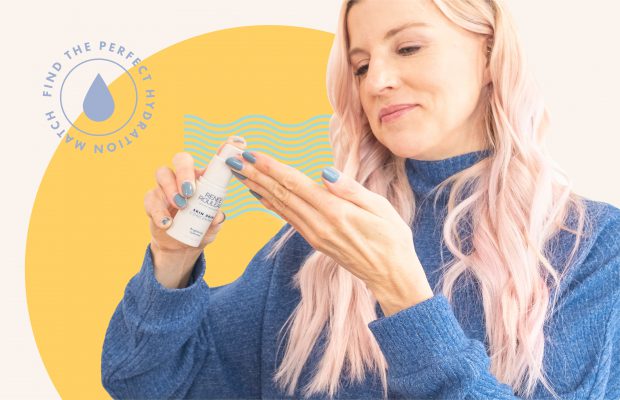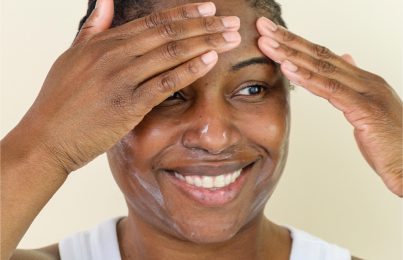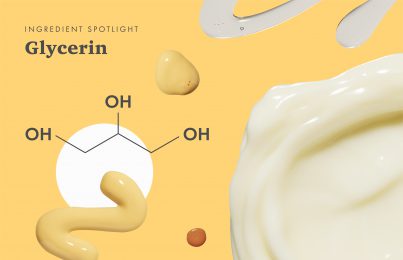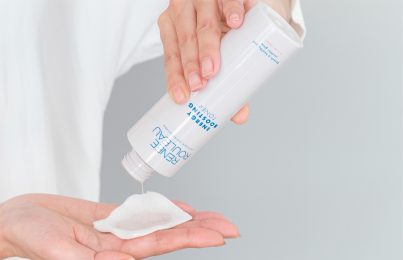Updated 10/18/22. Everyone wants plump, bouncy-looking skin. To achieve this, you must keep your skin hydrated.
In this post, I’ll share my favorite hydrating skincare ingredients. These are the ingredients I consider to be the most effective for boosting and maintaining water content in the skin. (Hint: there’s more out there than just hyaluronic acid!)
Why Should I Be Using Hydrating Ingredients in My Skincare Routine?
Here’s the thing—skin cells are like fish in that they need water to live. This is true regardless of your skin type. So yes, that means hydration is necessary for everyone, even people with oily, breakout-prone skin. In fact, oily skin is often dehydrated. That’s why it’s so important to understand the difference between dry and dehydrated skin. Despite what you might have been told, they aren’t the same thing and they must be cared for differently.
Hydrating skincare ingredients, like the ones I’ll be talking about in this post, deliver that much-needed water into the skin. In the short term, they plump the skin, give it a glow, and soften fine lines. In the long term, they keep skin cells functioning properly to support a robust moisture barrier and to facilitate healthy aging.
Now that we’ve established the importance of hydration for all skin types, keep scrolling to see my favorite ingredients to use.
The Best Hydrating Skincare Ingredients
1. Hyaluronic Acid
Let’s start with one of the most popular and well-known hydrating skincare ingredients out there—hyaluronic acid. This is something your body produces naturally in order to keep skin, joints, and connective tissues lubricated. It’s a humectant, meaning it can plump and hydrate the skin by attracting water from the air as well as from the lower layers of the skin. It then binds the water to cells in the epidermis (the outermost layer of skin). It can hold around 1,000 times its weight in water.
It’s been around for a long time, but it’s become especially popular in the last few years thanks to media coverage. It seems like someone latched on to hyaluronic acid as a go-to ingredient and everyone else followed. Because of this buzz, there’s a perception that hyaluronic acid is the best hydrating ingredient. While it undoubtedly does a great job, it gets a disproportionate amount of praise. The reality is that there are a lot of great hydrating skincare ingredients out there. Some of them even offer additional benefits and may actually be a better fit for your skin type.
Speaking of skin types, hyaluronic acid is generally well-tolerated by all, but there is a potential drawback. If you’re using it in a dry environment where there’s very little moisture in the air, you run the risk of actually dehydrating your skin. This is because hyaluronic acid draws water from the deeper layers of the skin. If you don’t apply something with occlusive properties on top, to keep the moisture sealed in, it will evaporate into the air through something called Transepidermal Water Loss (TEWL).
To avoid this, simply pair hyaluronic acid with an occlusive, like a moisturizer or face oil. This creates a barrier between the skin and the air, preventing TEWL from happening.
Read the difference between humectants, emollients, and occlusives.
2. Sodium Hyaluronate
Sodium hyaluronate is the salt form of hyaluronic acid. It functions similarly to hyaluronic acid in that it helps recharge the skin’s moisture levels (it also binds up to 1,000 times its weight in water). Sodium hyaluronate is generally used more often than hyaluronic acid because of its heightened ability to penetrate the skin.
Thanks to its salt form, it’s also less likely to oxidize, meaning it’s a more stable ingredient than hyaluronic acid. This makes it a great option for anyone who has a damaged moisture barrier and experiences a high rate of TEWL caused by over-exfoliation, a dry climate, or excess sun exposure.
It does, however, have the same potential drawback as hyaluronic acid. If used in dry environments, it can actually dehydrate the skin. Pair it with occlusive ingredients to avoid this. (By the way, silicones are occlusive ingredients, and they’re not all bad. In fact, some of them can be really beneficial, even for oily, blemish-prone skin).
3. Glycerin
Glycerin is another humectant that’s been around for a long time. It also happens to be the most common. It’s derived from plant oils and the fermentation of sugars, or it can be synthetically produced. It attracts moisture from the air as well as from the lower layers of the skin to deliver it to the epidermis, which makes the skin feel moist and bouncy.
One advantage glycerin has over hyaluronic acid is that it has a smaller molecule size, so it can penetrate the skin more easily. However, that doesn’t mean the water it binds can’t evaporate. Just like with hyaluronic acid and sodium hyaluronate, it’s important to use glycerin with occlusive ingredients so the water remains sealed into the skin.
4. Tremella Fuciformis
This ingredient is a hydrating polysaccharide extracted from the fruit of the Chinese Silver Ear Mushroom. It holds 500 times its weight in water, making it a powerful humectant. It is also known as “the natural hyaluronic acid” and is sometimes called “tremella hyaluronic acid.” What I love about this ingredient is that, in addition to being an effective hydrator, it offers additional benefits. Although the mechanisms aren’t entirely clear, studies show it has antioxidant and anti-inflammatory properties. Perhaps that’s due to this extract’s polyphenol and flavonoid content, which are known antioxidants.
You can find this ingredient in the Skin Correcting Serum. I formulated this product specifically for sensitive, breakout-prone skin. Along with tremella fuciformis, it contains antioxidants and niacinamide to address inflammation and discoloration.
5. Trehalose
Of all the hydrating skincare ingredients on this list, this one is my personal favorite! Trehalose is an antioxidant found in desert “resurrection” plants. When desert plants dehydrate from lack of water, this molecule takes the place of water within the plant’s cells and acts as a stand-in. Once the dehydrated plant comes back into contact with water, trehalose will absorb it. It fills out the plant’s dehydrated cells without causing any damage to the membrane structures—even if the plant has been dormant for centuries. How cool is that?
I formulated the Rapid Response Detox Masque with trehalose to address moisture loss. It also contains sodium hyaluronate for added hydration, allantoin to help soothe skin, and salicylic acid to help keep pores clear.
6. Panthenol
Panthenol is a B5 provitamin, meaning the body turns it into vitamin B5. It softens the skin and acts as both a humectant and an emollient. That means it helps skin cells attract moisture and seal it in. The result? Skin cells are hydrated and the function of the moisture barrier is improved.
7. Sodium PCA
Sodium PCA is the salt form of pyroglutamic acid (an amino acid similar in structure to proline). It occurs naturally in various plants and is also part of your skin’s Natural Moisturizing Factor (NMF). Sodium PCA primarily acts as a hydrator thanks to its humectant properties. It doesn’t hold as much water as hyaluronic acid, but you can combine the two for a powerful hydrating effect overall.
You can find this ingredient in the AHA/BHA Blemish Control Cleanser, which is a product I formulated specifically for oily and breakout-prone skin types to help exfoliate and prevent blemish-causing bacteria from causing issues, without stripping the skin of moisture or causing irritation.
There you have it. These are my all-time favorite hydrating skincare ingredients! Each of these ingredients is tolerated well by most skin types, and they can even be combined to increase efficacy. Even if they aren’t listed high up on an ingredient list, they can effectively fight dehydration. (Learn more about how to understand ingredient percentages.)
Next, use these 20 active ingredients if you want to improve your skin.
Celebrity Esthetician & Skincare Expert
As an esthetician trained in cosmetic chemistry, Renée Rouleau has spent 35 years researching skin, educating her audience, and building an award-winning line of products. Her hands-on experience as an esthetician and trusted skin care expert has created a real-world solution — products that are formulated for nine different types of skin so your face will get exactly what it needs to look and feel its best. Trusted by celebrities, editors, bloggers, and skincare obsessives around the globe, her vast real-world knowledge and constant research are why Marie Claire calls her “the most passionate skin practitioner we know.”




Comments:
I recently started using a Grapefruit Seed Extract on my face a few drips mixed with a
my HA serum and a peotide serum and WOW !
I accidently came upon this as I was applying it to the backs of my hands for a few keratosis spots or flat warts as I was not sure which they were. And I noticed aftwr doing this a few nights that my gands which have been looking very dried and old were looking more taut and toned. I was like hmnnn … maybe its just drying them out so they just appear more toned. No, they continue to look better and better. So I though well heck it cant hurt to put a few diluted drop on my face. I have reactive skin so I have a really hard time using any antiaging products except for oeptides and HA or moisturiser even Vit C is harsh for me. I knew that GSE is a mild exfoliant and has antioxidants in it and can be used as a vit C alternative , so I forged ahead and experimented on myself. Wow , is all I can say . My skin has a glow and appears more taut. It works for me:)) and has not dried my skin out as I only use 2 drops mixed in my serums.
Posted By: Ann |
For more on anti-aging your hands check out this blog post! https://blog.reneerouleau.com/secrets-to-beautiful-younger-looking-hands-from-a-hand-model/
Posted By: Renée Rouleau |